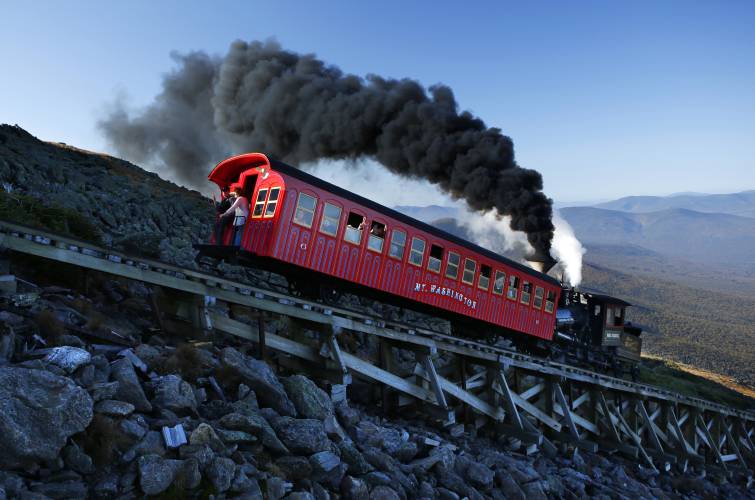NH hiker makes an “innumerous amount of poor decisions” before Cog Railway rescue

FILE- A vintage coal-fired steam engine pushes a passenger car up the Cog Railway on a 3.8-mile journey to the summit of 6,288-foot Mount Washington in New Hampshire, Sunday, Sept. 24, 2017. The owner of the railway is proposing accommodations and a restaurant near the summit of New Hampshire's highest peak. (AP Photo/Robert F. Bukaty, File) Robert F. Bukaty / AP
| Published: 02-19-2024 12:13 PM |
An injured hiker who made an “innumerous amount of poor decisions” was rescued from Mount Washington on Saturday amid wind chill of 50 degrees below zero, after rescuers were carried up the mountain in a special Cog Railway train.
According to New Hampshire Fish and Game, the first call came in just before noon on Saturday, Feb. 17, that 22-year-old Cole Matthes, of Portsmouth, N.H., had fallen while hiking in the Ammonusuc Ravine on Mount Washington. He called 911 and requested help. He was off trail in a drainage ravine west of Westside Trail and north of Crawford Path at approximately 4,500 feet in elevation.
Calls were made to Conservation Officers on the Advanced Search and Rescue Team, Androscoggin Valley Search and Rescue Team, and Mountain Rescue Service to start a response.
Due to the location, the Cog Railway provided better access than the Mount Washington Auto Road. The Cog Railway started a special train with a snow blower on the front to bring them to the Westside trail.
By then Matthes made his way to the Lakes in the Clouds Hut and was below the building in the emergency shelter, but still needed help. According to Fish and Game, conditions on Mt. Washington as this first team started across were sustained winds at 90 mph or more, a wind-chill of minus-52 degrees and an ambient temperature of minus-9.
The first group of rescuers were able to meet with Matthes at the Lakes emergency shelter at 6:17 p.m. Matthes was not injured but suffering from hypothermia and was wearing many layers of frozen clothes to include frozen hiking shoes. It took over three hours to slowly warm him.
“Matthes had to be stripped of his wet frozen clothes and placed in extra gear that rescuers had. His boots were thawed out to the point that his frostbitten feet could go back in them with dry wool socks that rescuers put on for him. After being fed and filled with warm liquids Matthes was brought down the Ammonusuc Ravine Trail with assistance,” the press statement said.
Twin Mountain Ambulance was at the Base Station and initially treated Matthes for hypothermia and frostbite. Matthes refused treatment and “was released from the ambulance and brought to his vehicle at 11:38 p.m., 12 hours after the initial call.
Article continues after...
Yesterday's Most Read Articles
 Dartmouth administration faces fierce criticism over protest arrests
Dartmouth administration faces fierce criticism over protest arrests
 Hanover house added to New Hampshire Register of Historic Places
Hanover house added to New Hampshire Register of Historic Places
 Sharon voters turn back proposal to renovate school
Sharon voters turn back proposal to renovate school
Fish and Game was highly critical of Matthes in their press statement:
“Matthes made an innumerous amount of poor decisions in regards to the hike that he planned in the White Mountains. Matthes did not have proper gear, equipment, weather planning, and or proper critical decisions in order to keep himself out of harm’s way. ... Matthes saw other groups turn around and say, ‘The weather isn’t worth it.’ But he decided to keep going.
“Matthes called for a rescue after making all these poor choices, and putting himself in a situation that placed 11 other lives in danger in order to save his. Even though the rescuers complete these heroic tasks with humility and passion there is still never ending concern as to why inexperienced solo hikers continue to push on.
“The list of people who have died on the Presidential Range will stay at 173 for now thanks to the rescue effort that saved Cole Matthes’ life.”

 Judge won’t reconvene jury after disputed verdict in New Hampshire youth center abuse case
Judge won’t reconvene jury after disputed verdict in New Hampshire youth center abuse case Students take down pro-Palestinian encampment at UVM
Students take down pro-Palestinian encampment at UVM
